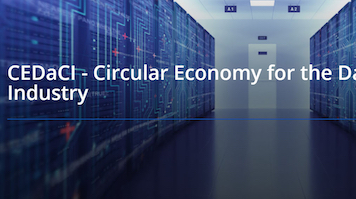
CEDaCI
Circular Economy for the Data Centre Industry (CEDaCI)
About CEDaCI
The data centre industry has grown rapidly and generates a large volume of electronic waste (eWaste) and waste electrical and electronic equipment (WEEE). The current infrastructure for dealing with this waste is underdeveloped and consequently, there is a real and urgent need to address this now. The Circular Economy for the Data Centre Industry (CEDaCI) built a Circular Economy for the Data Centre Industry by bringing together stakeholders from all equipment life-cycle stages to turn this waste into a useful resource and support the ongoing rapid growth of the industry. LSBU academics in the School of Engineering have been collaborating with the data centre industry for over 20 years.
Background and context
Since the development of the World Wide Web in the late 1980s, digital communication has proved incredibly popular and more than 5.18 billion people, or 64.6% of the global population (as of April 2023), are ‘connected’ via mobile phones, laptop, desk and other computers; consequently, approximately 8.6 million data centres have been set up around the world to handle the streams of digital information. These data centres may be cupboard-sized or, like, the largest in the world, equivalent in area to 93 football pitches. Regardless of size, they all house digital data processing, networking and storage equipment to ensure uninterrupted connectivity. At present, in Europe, data centres cover about 10 million m2 of floor area, 70% of which is concentrated in North-West Europe, especially in the UK, Germany, France and the Netherlands. The ongoing development of the Internet of Things (IoT) and other services is creating concurrent growth in data exchange and storage and it is predicted that this will require a 300% increase in data centres in Europe by 2025 and a 500% global increase in data centres by 2030.
The challenge
The main priority of the data centre industry is uninterrupted operation and service to customers and consequently the sector has concentrated its attention on technology and product development, manufacture and operation. At present, the life of a set of data centre equipment is only 1-5 years and consideration of what happens to the equipment when it reaches end-of-life has been limited. As a result, data centres contribute to the annual global production of 11.8 Mt/year of WEEE, which is one of the fastest growing waste streams. Although some equipment remains in Europe, a significant volume is exported; it may be recycled, stockpiled and/or sent to landfill and consequently millions of tonnes of resources are wasted and/or become inaccessible. WEEE contains a number of critical raw materials (CRM) which are economically valuable and technically essential to data centre operations; however, their supply is vulnerable to disruption.
The project
The CEDaCI project built a circular economy for the data centre industry to increase recovery and reuse of CRM in the sector; extend product life through equipment reuse and remanufacture; reduce the use of virgin materials, waste and environmental impact arising from the growth in redundant equipment; and develop a secure and economically viable CRM supply chain for the sector. At the time, only 10% of CRMs from the sector were recycled and recovered but this would increase to 19% and 24% in five and ten years respectively after the project ends; reuse of equipment would also increase to 65% and 75% respectively, and at end-of-life overall product ‘waste’ would be reduced to 35% and 25%
Aims of project
The aims of the project were to:
- Extend product life through second use and refurbishment
- Increase dematerialisation through improved EcoDesign Guidelines
- Increase WEEE collection, processing and recycling in the EU and adherence to EU regulations
- Create jobs in North-West Europe
- Decrease illegal export of sectoral WEEE
- Limit stockpiling of resources overseas
- Ensure the control of the materials manufacture and supply chains of the data centre sector in North-West Europe.
Research method and output
The aims and objectives of the project were achieved through a whole-life approach to the problem: the project brought together stakeholders from across the sector including designers, manufacturers, operators, refurbishers and recyclers. Collaborating in a knowledge-sharing network, they engaged on a co-creation platform and three integrated pilots for three life-cycle stages (design, life extension and end-of-life).
The project output included: two products, processes or technologies developed and tested in real life conditions; EcoDesign/Design for circular economy guidelines (to accelerate the manufacture of circular economy-fit products); a Decision-Making Tool (DMT) for all data centre sub-sectors to optimise circular economy business models; and improved refurbishment, recycling and recovery strategies for WEEE and CRMs.
These would feed into bespoke technical assistance (DMT training sessions) for 50 data centre industry businesses; advice and guidelines for policy makers and policy influencers; and a physical and virtual demonstrator that explains the circular economy context, processes and benefits. A long-term strategy with a ten-year maintenance plan will ensure the project’s impact and long-term legacy.
CEDaCI Network
The multi-disciplinary CEDaCI network brings together actors and experts from all life-cycle stages and sub-sectors directly and indirectly associated with the data centre industry. Network membership helps the organisations to make the best choices to develop and grow their business sustainability, through access to example case studies, business models, and a DMT. The organisations can also connect to the CEDaCI project partners and other network members, and identify business opportunities.
You can obtain information on CEDaCI from the Lead Partner at LSBU, Professor Deborah Andrews, deborah.andrews@lsbu.ac.uk.